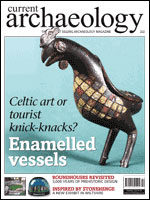It’s been a busy few weeks at Current Archaeology, with each of us off on various field projects and conferences, including the World Archaeological Congress in Dublin (see Reviews, p. 46). One topic that has been on everybody’s mind this month is the BBC’s new archaeology programme Bonekickers. Do shows like this pose a threat to archaeology through providing a semblance of credibility, while simultaneously misrepresenting the science and structure of professional archaeology? Or, is the show purely entertainment, and might it serve archaeology by popularising the discipline and keeping it in the public eye? Let us know what you think. Our features this month are an eclectic mix of up-to-the minute information: new ideas on familiar topics (Roundhouses), new discoveries and interpretations (Enamelled vessels), new exhibitions (Stonehenge) and new rescue digs (Northern pipeline and Easington). Happy reading!ROUNDHOUSES: 3,000 YEARS OF PREHISTORIC DESIGNIn CA 21 (1970), we reported that only 200 roundhouses were known to archaeology. Today, the number of excavated roundhouses has risen to more than 4,000. Rachel Pope tells CA what has been learned about the design, use, and landscape setting of British prehistory’s standard ‘family home’. ENAMELLED VESSLS FROM ROMAN BRITAIN: CELTIC ART AND TOURIST KNICK-KNACKSArchaeologists are agreed that most of the bigger enamelled vessels of the Roman period came from Britain ‘Britain produces gold, silver, and other metals,’ declared Tacitus around AD 100. So, were Celtic artists making tourist knick-knacks for Roman soldiers to take back home? Examples of their work has been found throughout Europe. Leading expert Ernst K√ɺnzl puts a British ‘souvenir’ into context.INSPIRED BY STONEHENGEArchaeologist Julian Richards has been collecting Stonehenge memorabilia for almost 30 years. From the serious and the educational to the absurd and the fanciful, Stonehenge is the subject of a truly diverse range of souvenirs. Julian’s collection now forms the core of a new exhibition, Inspired by Stonehenge, at the Salisbury Museum. We asked him to explain what it is that has made these kitschy objects so fascinating for an archaeologist.VILLAGE, CEMETERY AND DYKE: THE ARCHAEOLOGY OF A NORTHERN PIPELINEThe terminal at Easington has the capacity to supply 20% of Britain’s natural gas. To feed it into the existing supply network, a new 240km-long pipeline is being built right across the North. Richard Moore reports on the work of Network Archaeology recording the archaeological evidence along the route.FROM BRONZE AGE BRIQUETAGE TO SAXON SPEARHEADSThe Easington natural gas terminal is a key hub of the British energy industry. However, 2,000 years ago, the same site was a thriving, but remote, Iron Age farming village. Before work began on new construction at the terminal, a rescue excavation was undertaken, which has revealed the rise and fall of the civilisation that flourished there for two and a half centuries.ODD SOCSSPAB’s (Society for the Protection of Ancient Buildings) Mill’s Section
Current Archaeology 222
In this issue:
-Enamelled bronzes from Roman Britain Celtic art and tourist knick-knacks
-From Bronze Age briquetage to Saxon spearheads
-Inspired by Stonhenge
-Museum staff on strike Low pay crisis in British archaeology
-Roundhouses 3000 years of prehistoric design
-Sixth World Archaeological Congress The Olympics of Archaeology
-SPAB’s Mills Section Odd Socs
-Village, cemetery, and dyke The archaeology of a northern pipeline
Plus: News, Reviews, Comment, Diary, and more!
£6.95
Availability: 15 in stock
Description
Additional information
| Weight | 0.178 kg |
|---|---|
| Rest of World Delivery | £2 |
| Volume | Volume 19 |
| Published Year | 2000s |
| Cover Date | Sep-08 |
| Volume Name | Volume 19 Issue 6 |

